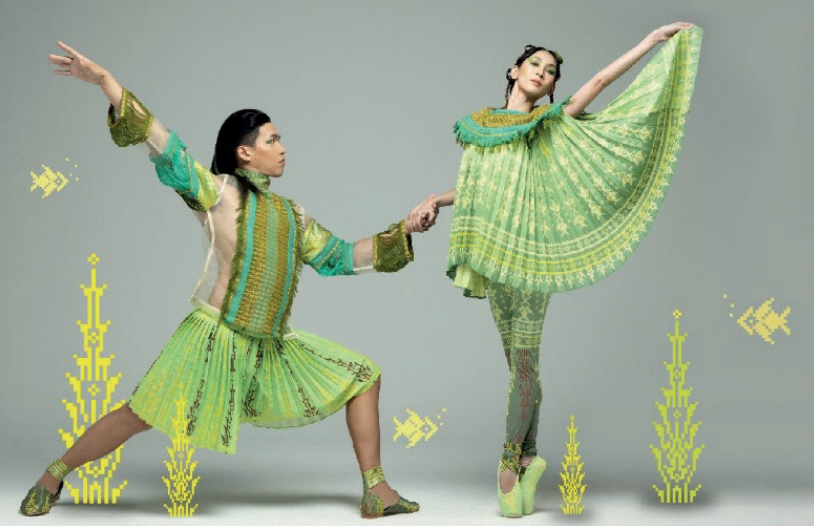The Creation of Products from Cultural Capital of Sukhothai
DOI:
https://doi.org/10.69598/decorativeartsjournal.2.58%20-%2095Keywords:
products, cultural capital, SukhothaiAbstract
This research article was part of the project “New Outlook on the Old Capital City: A Workshop on Preserving and Promoting Cultural Heritage, Identities, and Expressions through Contemporary Design in Sukhothai Province”, and it was conducted by the Office of Contemporary Art and Culture, Ministry of Culture. It received budget support from UNESCO and the cooperation from Naresuan University, Uttaradit Rajabhat University, Srisatchanalai Industrial and Community Education College, Institute of Culture and Arts of Srinakharinwirot University, weaving community, and jewelry entrepreneurs in Sukhothai Province. The purposes were to educate young people in terms of cultural capital in Sukhothai, to create products from cultural capital of Sukhothai, and to display works through a virtual exhibition. The research was conducted by studying relevant documents, organizing the training to provide knowledge, visiting the area, designing, and creating products. The research instruments were interviews with experts in Sukhothai cultural capital, training assessment form, and satisfaction assessment form regarding the virtual exhibition. The results of the research showed that, in terms of providing knowledge to the youth regarding Sukhothai cultural capital, there were 58 participants from three provinces, including Phitsanulok, Uttaradit, and Sukhothai. The knowledge about history and architecture was provided by Mr. Teerasak Thanusilp, an archaeologist at Archaeological Research and Development Group, Archeology Division, Fine Arts Department, the knowledge about the creative city was provided by Mr. Weerawit Chanthawarang, Director of Designated Areas for Sustainable Tourism Administration (DASTA) 4 as the main coordinator of Sukhothai Creative City Network, the knowledge about jewelry was provided by Mr. Kritphet Attawong, the knowledge about basketry was provided by Assistant Professor Dr. Kritphet Attawong, the knowledge about Sukhothai textiles was provided by Dr. Thadchai Yuying, and the knowledge about wthe creation of designs from culture was provided by Mr. Wisharawish Akarasantisook. It was found that the participants in the training received knowledge about the cultural identity of Sukhothai Province. They were aware of the importance of Thai arts and culture and were stimulated to have creativity and participation in the development of the creative city. Also, the knowledge could be extended to use in design works and future communities. Additionally, they were inspired to apply contemporary design from cultural capital. When the concept of applying culture was learned, it would affect the variety of creative products, even playing a part in the development of the domestic and international economy. In terms of creating the products that were designed using inspiration from various aspects of Sukhothai cultural capital, there were four products, including 1) five hand-woven fabric products consisting of Lotus of Wisdom, Sukhothai Symbol, Pikul, Firework Festival, and A Fertile Land of Fish and Rice, 2) Augmented Reality (AR) technology combined with woven fabric patterns, 3) four sets of silver jewelry, consisting of Celadon Pattern Set, Wicker Set, Celadon Set, and Thai Carp Set, and 4) 10 sets of apparel products made from woven and printed fabrics and 10 pairs of shoe products made from printed fabrics. Regarding displaying works through the virtual exhibition which presented creative works in various forms such as 3D images, photographs, and videos, there were four zones, consisting of Zone 1 showing women's and men's clothing using woven fabrics and printed fabrics from the project, Zone 2 showing fabrics, Zone 3 displaying a variety of shoes and accessories, and Zone 4 displaying design sketches of the youth who participated in the training. It was assessed by five experts from the Office of Contemporary Art and Culture, Ministry of Culture. It was revealed that the information was useful and could be used further. The illustrations and videos were beautiful and clear. The information was clear and accurate. Also, the information was meaningful and easy to understand. As for 3D structural design and the plan of the virtual museum, it was revealed that the menu system was easy to use. The font size and font style were beautiful and easy to read. Accessing the system was easy, convenient, and fast. The amount of information was sufficient to meet the needs. Moreover, the speed of displaying information (e.g., images, videos, and texts) was high.
References
กระทรวงวัฒนธรรม. (2566). แผนปฏิบัติราชการ ระยะเวลา 5 ปี ของกระทรวงวัฒนธรรม. กระทรวงวัฒนธรรม
กลวัชร คล้ายนาค. (2551). การสร้างพิพิธภัณฑ์เสมือนจริงเพื่อส่งเสริมการศึกษาสถาปัตยกรรมไทย : กรณีศึกษาเรือนไทยลื้อ. มหาวิทยาลัยเชียงใหม่.
ดนัย เรียบสกุล. (2565). Cultural Creativity การสร้างสรรค์ทางวัฒนธรรม: สุโขทัย. ภาพพิมพ์. สำนักงานศิลปวัฒนธรรมร่วมสมัย กระทรวงวัฒนธรรม.
ดิเรก ปัทมสิริวัฒน์. (2545). ถึงเวลา...แปลงวัฒนธรรมเป็นทุน. สภาที่ปรึกษาเศรษฐกิจและสังคมแห่งชาติ.
บุญชู บุญลิขิตศิริ และคณะ. (2558). รูปแบบพิพิธภัณฑ์ศิลปวัฒนธรรมเสมือนภาคตะวันออก. มหาวิทยาลัยบูรพา
บุศรา วัชรกาฬ. (2553). การจัดการทุนทางวัฒนธรรม: ชุมชนบ้านคลองวัว หมู่ที่ 5 ตำบลเหมืองใหม่ อำเภออัมพวา จังหวัดสมุทรสงคราม. มหาวิทยาลัยเกษตรศาสตร์
แผนการศึกษาแห่งชาติ พ.ศ. 2560 – 2579. (2560). ของสำนักงานเลขาธิการสภาการศึกษา กระทรวงศึกษาธิการ
พนิตสุภา ธรรมประมวล. (2560). การอนุรักษ์ ฟื้นฟู และพัฒนาศักยภาพทุนทาง วัฒนธรรมชุมชนลาวแง้ว ตำบลทองเอน อำเภออินทร์บุรี จังหวัดสิงห์บุรี. คณะวิทยาการจัดการ มหาวิทยาลัยราชภัฏเทพสตรี.
วันทนา สุวรรณรัศมี. (2551). รูปแบบพิพิธภัณฑ์เสมือนจริงเพื่อการศึกษา. เทคโนโลยีการศึกษา มหาวิทยาลัยเกษตรศาสตร์.
สัญญา สดประเสริฐ, พระครูใบฎีอภิชาต พรสุทธิชังพงศ์, พระครูปลัดประวิทย์ ทรัพย์อุไรรัตน์ และพระครูใบฎีกาธีรยุทธ ภู่โคกหวาย. (2563). กลไกขับเคลื่อนเศรษฐกิจและสังคมในการพัฒนาศักยภาพทุนทางทรัพยากรและทุนทางวัฒนธรรมไทย. มหาวิทยาลัยมหาจุฬาลงกรณราชวิทยาลัย วิทยาลัยสงฆ์พุทธปัญญาศรีทวารวดี.
สำนักเลขาธิการสภาการศึกษา กระทรวงศึกษาธิการ. (2560). แผนการศึกษาแห่งชาติ พ.ศ. 2560 – 2579. กระทรวงศึกษาธิการ.
อาทิตย์ บุดดาดวง และสุภรรณี ไชยอำพร. (2555). ความสามารถในการนำทุนทางสังคมออกมาใช้ของชุมชนบ้านบางไพร อำเภอบางคนที จังหวัดสมุทรสงคราม. คณะพัฒนาสังคมและสิ่งแวดล้อม สถาบันบัณฑิตพัฒนบริหารศาสตร์.
Foo, S. (2008). Online virtual exhibitions: Concepts and design. Considerations.

Downloads
Published
How to Cite
Issue
Section
Categories
License
Copyright (c) 2023 DEC Journal

This work is licensed under a Creative Commons Attribution-NonCommercial-NoDerivatives 4.0 International License.
Published by Academic Affairs Division, Faculty of Decorative Arts, Silpakorn University. The copyright of the article belongs to the article owner. Published articles represent the views of the authors. The editorial board does not necessarily agree with and is not responsible for the content of such articles.


